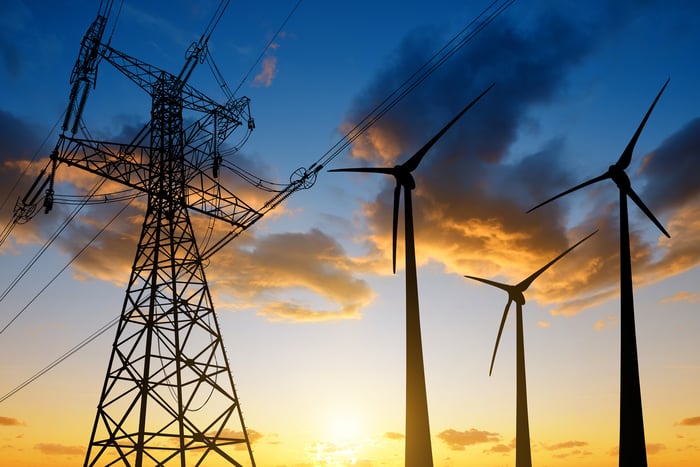For years, technology stocks have dominated the discussion on Wall Street. Potential game-changing innovations like artificial intelligence (AI), virtual and augmented reality, and blockchain technology, have captivated the attention (and wallets) of growth-seeking investors who don't want to miss out on the next big trend.
But amid this search for the next great growth stock, a number of amazing deals in traditionally safe sectors and industries have fallen through the cracks. Within the utility sector, two superb businesses, which are cheaper than they've been in at least a decade, serve as perfect examples.

Image source: Getty Images.
NextEra Energy
First up is the largest electric utility stock by market cap, NextEra Energy (NEE 1.02%).
After more than two decades of virtually uninterrupted positive annual returns, including dividends paid, shares of NextEra were taken to the proverbial woodshed in 2023. Excluding dividends paid, NextEra stock shed 27% of its value, which is an even worse one-year performance than during the height of the financial crisis in 2008 when its stock lost 26%
There have been two easy-to-identify downside catalysts for NextEra Energy. Rapidly rising yields on short-term Treasury bills have been the first issue. Instead of investors risking their principal purchasing utility stocks, they can protect their initial investment with ultra-safe U.S. Treasuries that are yielding a hearty 5%.
The other concern for NextEra was the announcement from NextEra Energy Partners (XIFR -1.56%) in September that it would be reducing its annualized dividend growth target to 6% through 2026 from a prior forecast of 12%. This left Wall Street concerned that NextEra Energy Partners would be involved in fewer renewable energy dropdown transactions with parent NextEra Energy.
While these are tangible concerns for NextEra Energy, the company's operating results suggest it's still firing on all cylinders and keeping its foot on the accelerator.
NextEra's defining characteristic is its renewable energy focus. When the curtain closed on 2023, the company had 72 gigawatts (GW) of capacity in operation. Half of this capacity (36 GW) derives from clean energy sources. In fact, the 24 GW NextEra generates from wind, and the 7 GW in capacity it nets from solar, are both tops in the world for an electric utility.
There are two advantages to having a renewable-energy focus. The obvious is that it meaningfully lowers electricity generation costs for NextEra. Investing in a green future has helped NextEra sustain a 10% annualized earnings growth rate since 2013.
Additionally, it puts NextEra Energy ahead of the curve if and when the U.S. government requires utilities to shift to cleaner energy sources.
NextEra Energy has no plans to slow or halt its renewable-energy investments, even with interest rates having soared over the last two years. The company has stood firm on its expectation that 32.7 GW to 41.8 GW of collective wind, solar, energy storage, and wind powering projects will come online between the start of 2023 and end of 2026.
Despite NextEra's outsized growth rate, shares of the company can be purchased right now for a multiple of just 17 times forward-year earnings. This is its lowest forward earnings multiple in at least a decade, based on where it closed out the prior 10 years. With annual dividend growth of around 10% and a current yield of 3.2%, NextEra Energy may never be this cheap again.

Image source: Getty Images.
York Water
On the other end of the spectrum, water utility stock York Water (YORW -0.19%), which sports a diminutive $484 million market cap next to NextEra's $131 billion valuation, has all the hallmarks of a screaming buy.
Shares of his tiny water and wastewater services provider in South-Central Pennsylvania have shed 25% of their value since the opening bell rang in 2023. The culprit for this poor performance, much like NextEra above, is rapidly rising Treasury yields and higher interest rates.
The management team at York has historically leaned on bolt-on acquisitions to expand its customer base. Debt-based financing can also be used for infrastructure upgrades. As of the end of 2023, York Water had $180 million in long-term debt, which could become costlier to service in a sustained higher interest rate environment.
Although interest rates have worked against York Water over the past two years, there are a couple reasons why now is the perfect time to pounce on shares of this under-the-radar water utility stock.
To start with, York is a regulated utility. In simple terms, this means York is unable to raise rates on its customers without the expressed approval of a state public utility commission -- in this instance, the Pennsylvania Public Utility Commission, or PPUC. Though I can understand this might sound like an operating constraint, it's actually good news. Being regulated means York isn't exposed to potentially unpredictable wholesale pricing. It also means the company's operating cash flow is highly predictable, which comes in handy when outlaying capital for new projects and bolt-on acquisitions.
In January 2023, York Water was given the green light by the PPUC to increase rates on approximately 75,000 of its customers to recover $176 million worth of infrastructure investments. As a result of this rate hike, York's operating revenue jumped by 18% last year to north of $71 million.
I'd be remiss if I didn't also mention that utilities often operate as monopolies or duopolies in the areas they service. Since York's water and wastewater customers don't have the ability to "shop around," and virtually every homeowner and renter requires water and wastewater service, York's operating cash flow tends to be transparent and predictable from one year to the next.
But what makes this tiny water utility so superb is its dividend history. I've dubbed York Water "Wall Street's Greatest Dividend Stock" because it's paid an uninterrupted dividend since its founding in 1816. That's 208 consecutive years of payouts, which is about 60 years longer than the next-closest publicly traded company.
Since this century began, York Water's stock has effectively doubled up the nominal return of the benchmark S&P 500 (496% to 242%), and absolutely clobbered it inclusive of dividends paid (1,030% vs. 443%).
Shares of York Water can be scooped up by opportunistic investors right now for precisely 20 times forward-year earnings. That's it lowest forward-year multiple in a decade, and a 37% discount to its average forward-year earnings multiple over the trailing-five-year period.





